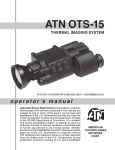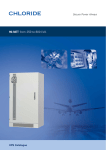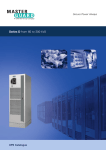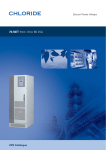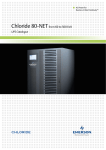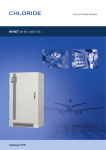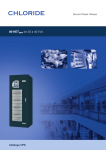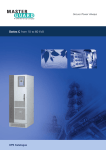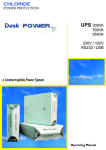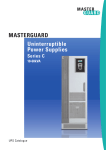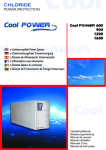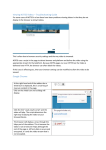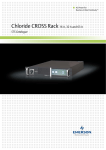Download 80-netmpr - DESITEK A/S
Transcript
COP MKA4CAT0UK80NET-MPR UK.qxd
17-10-2008
10:07
Pagina 2
Secure Power Always
MKA4CAT0UK80MPR
80-NETMPR from 30 to 40 kVA
UPS Catalogue
COP MKA4CAT0UK80NET-MPR UK.qxd
17-10-2008
10:07
Pagina 3
Important note!
The technical data enclosed is for general information.
Please note that the operating instructions and references
indicated on the products are for installation, operation and
maintenance.
Product designations
All product designations used are trademarks or product
names of Chloride Group PLC or its subsidiary companies.
This publication is issued to provide outline information and
is not deemed to form any part of any offer or contract.
The company has a policy of continuous product
development and improvement and we therefore reserve
the right to vary any information quoted without prior notice.
Person to contact
INTERNO CAT0UK80NETMPR-UK.qxd
17-10-2008
10:02
Pagina 1
Uninterruptible Power
Supply Systems
UPS Catalogue • 2008
80-NETMPR
from 30 to 40 kVA
01
Scope
2
System description
2
Device description
3
General requirements
5
AC/DC Converter (PFC Rectifier + Booster with IGBT)
6
Battery charger
6
DC/AC IGBT Converter (Inverter)
8
Electronic static switch (Bypass)
9
Monitoring and control, interfaces
10
Mechanical data
14
Environmental conditions
14
Technical data (30 to 40 kVA)
15
Options
19
Parallel configuration
21
Special version
22
Appendix: Planning and installation
26
MK4CAT0UK80MPR/Rev 1-09/2008/UK
INTERNO CAT0UK80NETMPR-UK.qxd
17-10-2008
10:02
Pagina 2
CHLORIDE 80-NETMPR
UPS Systems from 30 to 40 kVA
1 Scope
This
specification
describes
a
continuous, duty three-phase, solid
state, IGBT (Insulated Gate Bipolar
Transistor),
double
conversion,
uninterruptible power supply (UPS)
system. The UPS will automatically
provide continuity of electrical power,
within defined limits and without
interruption,
upon
failure
or
degradation of the commercial AC
source.
The continuity of conditioned electric
power will be delivered for the time
period defined by the battery system.
The rectifier, the inverter, and other
mission critical converters within the
UPS, are driven by vector control
algorithms (covered by patents 95
P3875, 95 P3879 and 96 P3198)
running on dedicated digital signal
processor (DSP) systems.
2.1 The system
The UPS will automatically provide
continuity of the electrical power,
within defined limits and without
interruption, upon failure or degradation
of the commercial AC source. The
duration of autonomy (i.e. back up
power time) in the event of a network
failure will be determined by the
battery capacity.
2 System description
80-NETMPR is an intelligent double
conversion UPS, as shown in Figure 1.
The systems will operate on a DSPbased IGBT inverter. Through Vector
Control technology, the performance of
the inverter will be enhanced and will
be capable of providing reliable, high
quality AC power. In order to increase
system redundancy, an independent
electronic static bypass will be
integrated into the UPS. By adding
system components, safety and
disconnecting devices, system bypass
switches, as well as software and
communications solutions, it will be
possible to set up elaborate systems
ensuring the complete protection of
the supplied loads.
The UPS will provide high quality AC
power for electronic equipment loads
and will offer the following features:
• Increased power quality
• Full input Power Factor Correction
(PFC) and very low THDi
• Full compatibility with any TN
installation and/or any standby
power generator
• Full compatibility with all types of loads
• Power blackout protection
• Full battery care
• Energy saving features
• Transformer free design (galvanic
isolation transformers are available as
integrated standard options)
QS3
Maintenance Bypass
Electronic Bypass
Bypass
Input
QS2
U2/ V2/ W2
Booster
Rectifier
Primary
Input
Inverter
QS4
QS1
U1/ V1/ W1
Load
U3/ V3/ W3
QS5
Only for Service
N1/2
N3
Battery Charge
int. Battery
QS6
QS7
ext. Battery
C+
D-
Figure 1. 80-NETMPR single line diagram.
MK4CAT0UK80MPR/Rev 1-09/2008/UK
02
INTERNO CAT0UK80NETMPR-UK.qxd
17-10-2008
10:02
Pagina 3
CHLORIDE 80-NETMPR
UPS Systems from 30 to 40 kVA
2 System description
2.2 Models available
MODEL
Rating (kVA)
The 80-NETMPR range will include the
following three-phase input/output
models:
80-NETMPR /30
30 kVA
80-NETMPR /40
40 kVA
3 Device description
80-NETMPR is the result of an innovative
research and development programme,
designed to offer users the most
reliable power supply, at the minimum
cost and with the highest possible
energy conversion efficiency.
conversion or digital interactive mode
according to the selected priority. The
UPS will operate as follows:
3.3.1 Double Conversion Mode (DCM)
or restoration of the commercial AC
source. While the UPS is powered by
the batteries, indications will be
provided of the actual autonomy time
remaining as well the duration of the
mains failure.
3.3.1.1 Normal (DCM)
3.1 Components
The UPS will consist of the following
major components:
•
•
•
•
•
•
•
•
PFC Rectifier & Booster with IGBT
IGBT Battery Charger
IGBT Inverter
Dedicated digital signal processor
(DSP) control
Embedded controller for I/O interfaces
Electronic static switch and by-pass
supply
Manual maintenance bypass switch
Matching battery cubicles
3.2 Microprocessor control and
diagnostics
Operation and control of the UPS
will be provided through the use
of microprocessor-controlled logic.
Indications, measurements and alarms,
together with battery autonomy, will be
shown on an illuminated, graphical
display (LCD). The procedures for start up,
shutdown and manual transfer of the
load, to and from the bypass, will be
explained in clear step-by-step sequences
on the LCD display.
3.3 Intelligent double conversion
operating modes
80-NETMPR will adopt intelligent double
conversion technology, which allows
the UPS to operate in double
3.3.1.4 Recharge (DCM)
The UPS inverter continuously supplies
the critical AC load. The rectifier derives
power from the commercial AC source
and converts it into DC power for the
inverter. The Battery Charger keeps the
Battery in a fully charged and optimum
operational condition. The inverter
converts the DC power into clean and
regulated AC power which is supplied
to the critical load (conditioned line).
The static switch monitors and ensures
that the inverter tracks the bypass
supply frequency. This ensures that any
automatic transfer to the bypass
supply (due to an overload etc.) is
phase and frequency synchronised and
does not cause an interruption to the
critical load.
3.3.1.2 Overload (DCM)
In the event of an inverter overload,
manual stop or failure, the UPS
automatically transfers the critical load
to the bypass line (if available) without
interruption.
3.3.1.3 Emergency (DCM)
Upon failure or reduction of the
commercial AC source (see the
Technical Data table for tolerances),
the inverter will supply the critical load,
drawing power from the associated
battery. There will be no interruption to
the critical load upon failure, reduction
03
Upon restoration of the commercial AC
source, even where batteries are
completely discharged, the rectifier will
automatically restart and will take over
the inverter and the battery charger will
recharge the batteries. This function
will be fully automatic.
3.3.2
Digital Interactive Mode (DIM)
If priority has been set to digital
interactive mode, the intelligent
double conversion technology will
allow 80-NETMPR to continuously
monitor the condition of the input
supply, including its failure rate, to
ensure maximum reliability for critical
users. On the basis of the analysis
performed, it will decide whether to
supply the load through the direct line
or through the conditioned line. This
operational mode, which allows
significant
energy
savings
by
increasing the overall AC/AC efficiency
of the UPS, up to 98%, is primarily
intended for general purpose ICT
applications. However, it does not
provide the same output power quality
as when the UPS operates in double
conversion mode. It will therefore be
necessary to verify whether this mode
is appropriate for special applications.
The digital interactive mode is not
available for parallel systems.
MK4CAT0UK80MPR/Rev 1-09/2008/UK
INTERNO CAT0UK80NETMPR-UK.qxd
17-10-2008
10:02
Pagina 4
CHLORIDE 80-NETMPR
UPS Systems from 30 to 40 kVA
3 Device description
3.3.2.1 Normal (DIM)
The operating mode will depend on the
quality of the mains supply from the
short-term past. If the line quality has
remained within the permitted
tolerance parameters (see the
Technical Data table for tolerances)
throughout this timeframe, the direct
line will provide a continuous supply to
the critical AC load through the bypass
static switch. The IGBT inverter control
will remain in constant operation and in
synchronisation with the direct line
without driving the IGBT. This ensures
that the load can be transferred to the
conditioned line, without any break in
supply, in cases where there is a
deviation from the selected input
power tolerance levels. If the direct line
failure rate is outside the permitted
parameters, the 80-NETMPR will supply
the load from the conditioned line. The
battery charger supplies the energy
necessary for maintaining a maximum
charge to the battery.
unsuitable bypass mains supply, the
80-NETMPR will transfer the load from
the direct line to the conditioned line
(assuming that the 80-NETMPR was
operating from the direct line) and the
inverter will continue to supply the
critical load for a period of time that is
dependent on the degree of the
overload and the UPS features. Visual
and audio alarms will alert the user of
the problem.
3.3.2.4 Emergency (due to a mains
supply failure or a variance beyond
tolerance limits, DIM)
If the inverter is stopped for any
reason, there is no transfer to the
conditioned line and the load continues
to be supplied by the direct line. The
mains voltage and frequency values
must be within the tolerance limits
specified.
If the 80-NETMPR is supplying the load
via the direct line and the bypass mains
supply varies beyond the tolerance
levels (adjustable using the software),
the load will be transferred from the
direct line to the conditioned line. The
load will be powered from the mains
via the rectifier and inverter (until the
input mains remains within the
tolerances stated in technical data
table in Chapter 12). Should the input
mains fall below the lower limit, the
batteries will be used to power the load
via the inverter. The user is alerted to
the battery discharge by visual and
audio alarms and the remaining
autonomy is displayed on the LCD.
During this process, it is possible to
extend the remaining autonomy by
switching off non-essential loads.
3.3.2.3 Overload (DIM)
3.3.2.5 Return to normal conditions (DIM)
In the event of an overload, with a
duration in excess of the maximum
capacity that is specified for the bypass
static switch, the load is maintained on
the direct line and a warning message
on the LCD display will appear to warn
the user about the potential risks
related to this condition. This default
behaviour can be changed (via a
service accessible firmware setting) to
force the load to transfer to the
conditioned line (similar to that
described below) even if the bypass
source is available. In the event of an
overload in conjunction with an
When the mains supply returns within
the tolerance limits, the 80-NETMPR
will continue to supply the load via the
conditioned line for a period of time
that is dependant on the direct line
failure rate (the conditioned line draws
power from the mains, not the battery).
When the direct line has stabilised
the 80-NETMPR returns to normal
operation (DIM). As soon as the
mains returns the battery charger
automatically begins to recharge the
battery, so that maximum autonomy is
guaranteed in the shortest possible
time.
3.3.2.2 Inverter stop (DIM)
MK4CAT0UK80MPR/Rev 1-09/2008/UK
04
3.3.3
Maintenance bypass
If for any reason it is necessary to take
the UPS out of service for maintenance
or repair, the UPS will be fitted with an
internal maintenance bypass switch
which enables a load transfer to a
bypass supply with no interruption to
the critical load. Bypass isolation will be
complete and serviceable components
such as fuses and power modules etc
will be isolated. The transfer/retransfer
of the critical load may be
accomplished by the automatic
synchronisation of the UPS to the
bypass supply and by paralleling the
inverter with the bypass source, before
opening or closing the bypass switch
as appropriate.
3.3.4
Operation without battery
If the battery is taken out of service for
maintenance, it has to be disconnected
from the UPS by means of the battery
switches provided by the UPS or by the
external battery cabinet.
The UPS will continue to operate
and meet the performance criteria
specified with the exception of the
battery backup time.
3.4 Control and diagnostics
Control of the power electronics
modules will be optimised in order to
provide:
• optimum three-phase supply of the
load
• minimum line interferences upon
the supply network.
By using digital signal processors (DSP)
the 80-NETMPR will implement the
most advanced digital control.
3.4.1 Vector control
To ensure the quick and flexible
processing of measuring data, special
arithmetic
algorithms
will
be
implemented in the DSP, rapidly
generating controlled variables as a result.
INTERNO CAT0UK80NETMPR-UK.qxd
17-10-2008
10:02
Pagina 5
CHLORIDE 80-NETMPR
UPS Systems from 30 to 40 kVA
3 Device description
This will thus render possible the real
time control of the inverter electronics,
resulting in obvious advantages with
regards to the performance of the
power components. These advantages
will be:
Several algorithms included in the
Vector Control firmware are covered by
patents owned by Chloride (95 P3875,
95 P3879 and 96 P3198).
• Improvement of short circuit
behaviour, as individual phases can
be controlled more quickly
• Synchronism or phase angle
precision between the UPS output
and the bypass supply, even in the
case of a distorted mains voltage
• High flexibility in parallel operation:
parallel blocks may be housed in
separate rooms.
In order to maximise the reliability of
the system, the control unit will
monitor a wide number of operating
parameters for the rectifier, inverter,
charger and battery. All vital operating
parameters, such as temperatures,
frequency and voltage stability at the
system input and output, load
parameters and internal system values
will be constantly monitored and
controlled for irregularities at all times.
The system will automatically react
before a critical situation arises, either
from the UPS or the load, in order to
ensure that load is supplied even in these
difficult conditions.
3.4.2 Redundancy, preventive monitoring
3.4.3 Tele-diagnosis and tele-monitoring
In all the above modes of operation, the
UPS may be monitored and controlled
from a remote location such as a service
centre, in order to maintain the reliability
of the system at nominal levels. Even
during complete shutdown of the UPS,
the information relating to the operating
parameters will not be lost thanks to a
FRAM, which will store the information
for up to 45 years.
4 General requirements
4.1 Applied standards
Chloride
operates
a
Quality
Management
System
which
complies with BSI EN ISO 9001-2000
for the design, manufacture, sales,
installation, maintenance and service
of uninterruptible power supply
systems. The Chloride Environmental
Policy and Management Systems
comply with EN ISO 14 001 and
Chloride is committed to implementing
a policy of continuous improvement
to production processes and pollution
reduction. 80-NETMPR will carry
the CE mark in accordance with
the Safety European Directive
2006/95 (superseding the 73/23
and successive amendments) and
European EMC directive 2004/108
(superseding the 89/336, 92/31 and
93/68). 80-NETMPR is designed and
manufactured in accordance with the
following international standards:
• IEC/EN62040-1-1 general and safety
requirements
• EN62040-2 EMC requirements
• IEC/EN62040-3 operating requirements
• Classification according to IEC/EN
62040-3: VFI-SS-111
4.2 Safety
In terms of general and safety
requirements, the UPS conforms to
standard IEC/EN 62040-1-1 governing
use in unrestricted access locations.
4.3 EMC and surge suppression
Electromagnetic effects will be minimised
in order to ensure that computer systems
and other similar electronic loads will
neither be adversely affected by, nor
affect the UPS. The UPS will be designed
to meet the requirements of EN 62040-2,
class C3. The manufacturer and customer
in partnership agree to ensure the
05
essential EMC protection requirements
for the specific resulting installation.
4.4 Neutral connection and grounding
The 80-NETMPR output neutral will be
electrically isolated from the UPS
chassis. The input and output neutral
connections are the same, i.e. they are
solidly tied together. Therefore, the UPS
will not modify the state of the upstream
neutral, in any operating mode, and
the neutral state of the distribution
downstream from the UPS is imposed
by the mains one. The 80-NETMPR will be
used in installations with grounded
neutral. Further details please contact
Chloride Technical Support.
4.5 Materials
All
materials
and
components
comprising the UPS will be new and of
current manufacture.
MK4CAT0UK80MPR/Rev 1-09/2008/UK
INTERNO CAT0UK80NETMPR-UK.qxd
17-10-2008
10:02
Pagina 6
CHLORIDE 80-NETMPR
UPS Systems from 30 to 40 kVA
5 AC/DC Converter (PFC Rectifier + Booster with IGBT)
5.1 Primary input
provide DC power to the IGBT inverter.
The three-phase current taken from the
commercial AC source will be converted to
a regulated DC voltage by the rectifier and
booster. In particular, the booster will boost
the rectifier or battery DC voltage, creating
a split of the DC bus, which will allow the
inverter to recreate the AC nominal voltage
without the need of an inverter transformer.
In order to protect the power components
within the system, each phase of the
rectifier input will all be individually fitted
with fast-acting fuses. As shown in
Figure 1, the rectifier-booster stage will
5.2 Total Input Harmonic Distortion
(THD) and Power Factor (PF)
The maximum voltage THD (THDV)
permitted on the rectifier input (either
from the utility or generator) will be <8%.
The maximum current THD injected into
the mains (THDi) will all be less than 5%
at maximum input power and input
voltage THDV <1% (nominal input voltage
and current). Under these conditions, the
input power factor (PF) will be >0.99.
This means that the 80-NETMPR in double
conversion mode, will be seen by the
primary mains sources and distribution as
a resistive load (i.e. it will absorb only
active power and the current waveform
will be practically sinusoidal), thus
ensuring total compatibility with any
power source.
5.3 Operation with diesel generator
In order to obtain the required THD on the
input voltage, the coordination between the
diesel generator and UPS will be based on
the generator's sub-transient reactance, as
opposed to its short-circuit reactance.
6 Battery charger
6.1 Battery charger
This device will be able to completely
recharge the battery bank by delivering
DC power to the batteries with a very
low voltage and residual current ripple.
To recharge the batteries it takes power
from the AC input, when the primary
input mains is within the given tolerances.
6.2 Battery charger mode
This battery charger will be operable
with the following types of batteries:
Imput AC
Voltage
(Nominal Voltage)
100%
75%
Time
Battery
status
Charging/
floating
discharge
• Sealed Lead Acid (VRLA)
• Lead Acid
• Ni - Cd
The selection of the optimum charging
method will be completely managed by
the microprocessor. Several different
charging methods are available.
6.3 Voltage regulation, temperature
compensation
T1
MK4CAT0UK80MPR/Rev 1-09/2008/UK
Time
Figure 2. Battery status during reduction of the commercial AC source.
6.4 Residual ripple filtering
The battery charger output will have a
residual voltage ripple <1% RMS.
6.5 Capacity and charging characteristics
In order to ensure optimum battery
charging, the float voltage will be
automatically adjusted to the ambient
temperature. The battery charger is capable
of operating within the same tolerances as
the rectifier. A further reduction of the input
AC voltage (outside specified limits) will
inhibit the battery charger and the batteries
will be discharged.
T2
When the primary mains is not suitable
to supply the rectifier, the DC/DC
converter (booster module) will provide
the required power to the inverter by
using the energy stored in the battery.
After the discharge of the battery and
when the input AC power is restored,
the rectifier will power the inverter. The
06
batteries will be recharged through
the battery charger. The following
charging methods are an example of
the several methods available, giving
the possibility of matching the different
types of accumulators.
6.5.1 Sealed, maintenance-free lead
acid accumulators:
Charging is at constant current up to
the maximum floating voltage level.
Thereafter, the voltage will be kept at a
constant level within narrow limits
(single-step charging method).
INTERNO CAT0UK80NETMPR-UK.qxd
17-10-2008
10:02
Pagina 7
CHLORIDE 80-NETMPR
UPS Systems from 30 to 40 kVA
6 Battery charger
6.5.2 Sealed, low-maintenance lead acid
accumulators or NiCd accumulators:
Charging is at increased charging
voltage and constant charging current
(boost charge phase). When the
charging current falls short of a lower
threshold value, the battery charger
will automatically return to the floating
voltage level (two-step charging
method).
6.6 Overvoltage protection
The battery charger will automatically
switch off if the DC battery voltage
exceeds the maximum value that is
associated with its operational status.
6.7 Battery management
A short-time discharge of the battery will
be made to confirm that all the battery
blocks and connected elements are in
good working order. In order to preclude a
faulty diagnosis, the test will be launched,
at the earliest, 24 hours after the latest
battery discharge. The battery test will be
performed without any risk to the load,
even if the battery is completely
defective. Users will be alerted of a
detected battery fault. The battery test
will not cause any degradation in terms
of the battery system life expectancy.
6.7.3 Ambient temperature
compensated battery charger
The float voltage will be automatically
adjusted as a function of the temperature
in the battery compartment (3mV/K) in
order to maximize battery operating life.
6.7.4 Time compensated end of
discharge voltage
When the discharge time exceeds one
hour, the shutdown voltage will be
automatically increased, as shown in
Figure 3 for VRLA, to avoid prolonged
battery discharge as a result of a light
load.
6.7.5 Remaining battery life
uses
sophisticated
80-NETMPR
algorithms to determine the remaining
battery life, based on real operating
conditions such as temperature,
discharge and charging cycles and
discharge depth.
Using advanced battery care (ABC), the
80-NETMPR series will increase battery
life by up to 50%.
6.7.1 Operating parameters
When operating with maintenance
free, valve regulated lead acid battery
(VRLA), the parameters per cell will be
as follows:
• End of discharge voltage (V) 1.65 - 1.75
depending on load
• Shutdown imminent alarm (V) 0.05
over end of discharge voltage
• Minimum battery test voltage (V) 1.85
• Nominal voltage (V) 2.0
• Float voltage (V) 2.27 @ 20°C
6.7.2 Automatic battery test
The operating condition of the batteries
will be automatically tested by the
control unit at selectable intervals,
e.g. weekly, fortnightly or monthly.
Voltage
per cell
1.80
1.75
1.70
1.65
0
1
2
3
4
5
6
7
8
9
10
Time (hours)
Figure 3. End-of-discharge voltage in relation to discharge time.
07
MK4CAT0UK80MPR/Rev 1-09/2008/UK
INTERNO CAT0UK80NETMPR-UK.qxd
17-10-2008
10:02
Pagina 8
CHLORIDE 80-NETMPR
UPS Systems from 30 to 40 kVA
7 DC/AC IGBT Converter (Inverter)
7.1 AC voltage generation
From the DC voltage of the
intermediate circuit, the inverter will
generate sinusoidal AC voltage for the
user load on the basis of pulse-width
modulation (PWM). By means of the
digital signal processor (DSP) of the
control unit, the IGBT of the inverter
will be controlled so that the DC
voltage is divided up into pulsed
voltage packets. Thanks to a low-pass
filter, the pulse-width modulated signal
will be converted into sinusoidal AC
voltage. No isolation transformer is
needed for the IGBT inverter, with the
great benefits of energy conversion
efficiency, physical size and weight of
the modules.
7.2 Voltage regulation
The inverter output voltage on the
three phases will be individually
controlled to achieve the following
performances:
supply, will not deviate by more than ±6
% and is adjustable by ±0.2 to ±6%.
7.3.2 Frequency slew rate
The frequency slew rate will be <1Hz
per second.
7.8 Output voltage symmetry
The inverter will guarantee the
symmetry of the output voltages at
±1 % for balanced loads and for 100%
unbalanced loads.
7.9 Phase displacement
7.3.3 Frequency control
The inverter’s output frequency will be
controlled by a quartz oscillator which can
operate as a free running unit or as a slave
for synchronized operation with a separate
AC source. The accuracy of the frequency
control will be ±0.1% when free-running.
7.4 Total Harmonic Distortion
The inverter will provide harmonic
neutralization and filtering to limit the THD
on the output voltage to less than 1%
with a linear load. For reference, for a nonlinear load (as defined by IEC/EN62040-3)
the THD will be limited to less than 3%.
The phase angle displacement
between the three-phase voltages will
be 120° <±1 [°el] for balanced loads
and for unbalanced loads (0, 0, 100%)
7.10 Short circuit
The inverter short circuit capacity of
the 80-NETMPR, for the first 10ms,
will be >300% for any short circuit
configuration. After the first 10ms, it
will limit the current to =150% for no
longer than 5s and then it will shut
down.
7.11 Automatic upgrade of inverter
rated power
7.5 Neutral sizing
7.2.1 Steady state
The inverter steady state output
voltage will not deviate by more than
±1 % in a steady state condition, for
input voltage and load variations within
the quoted limits.
The sizing of the inverter neutral will be
oversized on all ratings in order to cope
with the combination of harmonics on
the neutral wire when driving singlephase, reference non-linear loads.
The inverter neutral is sized x 1.7 in
relation to the phase.
The inverter will automatically upgrade
its power as a function of ambient and
operating temperatures, as shown in
Figure 4. In the most common
conditions (25°C) the 80-NETMPR will
provide 10% more power than
nominal.
7.2.2 Voltage transient response
The inverter transient voltage will not
exceed Class 1 (VFI,SS,111) limits
when subjected to the application or
removal of 100% of the load as defined
by IEC/EN62040-3.
7.3
7.6 Overload
The inverter will be capable of
supplying an overload of 125% for ten
minutes and 150% for one minute of
the nominal power @ 25°C.
Output Power
110
Frequency regulation
7.7 Inverter shutdown
The inverter output frequency will be
controlled to achieve the following
performances:
7.3.1 Steady state
The inverter steady-state output
frequency, when synchronized to bypass
MK4CAT0UK80MPR/Rev 1-09/2008/UK
Ambient
Temperature
105
In the event of an internal failure, the
inverter will be immediately shut down
by the control unit. The UPS device or
the parallel-operated UPS systems will
continue to supply the load from the
bypass, without interruption, if it is
within permissible limits.
08
100
15
25
30
40
Figure 4. Automatic power upgrade.
INTERNO CAT0UK80NETMPR-UK.qxd
17-10-2008
10:02
Pagina 9
CHLORIDE 80-NETMPR
UPS Systems from 30 to 40 kVA
7 DC/AC IGBT Converter (Inverter)
7.12 Symmetrical Power Factor Output
Diagram
derating since the inverter will be
able to work at 100% of its power.
KVAr
Leading
100
Cos ϕ 0.5
80
10
0
%
A
KV
60
Cos ϕ 0.9
40
100% KW
20
0
Cos ϕ 1
25
50
75
100
20
40
Cos ϕ 0.9
60
Cos ϕ 0.8
80
100
Kw
100% KW
The full IGBT inverter is able to
supply, without derating, all kinds of
loads with a power factor up to 0.9
leading and lagging. This behavior is
achieved thanks to the perfect
dimensioning of all components of the
output stage, which allows the
obtaining of a Power Factor output
diagram perfectly symmetrical respect
to the zero. Thanks to this feature,
which is unique in the market,
the 80-NETMPR offers maximum
flexibility and compatibility with each
installation and means that the
customer doesn’t have to worry
about future modifications of the
loads with a different Power Factor.
As it is shown in figure 5,
it is clearly evident from the blue
area that every kind of load (leading or
lagging) with PF up to 0.9 will be
supplied by the UPS without any
Cos ϕ 0.6
KVA
100%
Lagging
Figure 5. Power Factor Output Diagram.
8 Electronic static switch (Bypass)
8.1 General
The bypass static switch will be a fully rated,
high speed, solid-state transfer device
and rated for continuous duty operation.
The following transfer and retransfer
operations will be provided by the
electronic static switch:
• Uninterrupted automatic transfer to
the bypass supply in the event of:
• inverter output overload
• battery voltage outside limits in
backup mode
• over-temperature
• inverter failure
• If the inverter and the bypass
supply are not synchronised in the
moment of a necessary transfer, a
switching delay can be set to protect
the critical load. This prevents any
possible damage to the load by an
unintentional phase shift.
• Uninterrupted manual transfer/retransfer
to and from the bypass supply will be
initiated from the control panel.
• Uninterrupted automatic transfer/
retransfer to and from the bypass
supply by activation of the digital
interactive mode
• Uninterrupted automatic retransfer
from the bypass supply, as soon as
the inverter regains the capacity to
supply the load in the case of
Double conversion priority
• The uninterrupted transfer from
the inverter to the bypass supply
will be inhibited in the following
situations:
• bypass supply voltage outside
limits
• failure of electronic bypass
switch
• frequency converter configuration
• The
uninterrupted
automatic
retransfer from the bypass to
inverter may be inhibited in the
following situations:
• manual switching to bypass
supply via the maintenance
switch
• UPS output overload.
• inverter fault
09
8.1.1 Voltage
The nominal voltage of the bypass line
will be 230/400 VRMS. Any transfer
from the inverter to the bypass line will
be inhibited if the voltage is beyond a
limit of ±10% (standard setting) of the
nominal voltage.
8.1.2 Transfer time (double conversion)
The switching time for a transfer from the
inverter to the bypass supply or vice
versa, will be less than 0.5ms when
synchronized. The system will ensure that
the inverter is stable and operating
normally before permitting the load to
retransfer to the inverter. The transfer
time when out of synchronization will be
20 milliseconds in order to prevent load
damage by phase reversal.
8.1.3 Overload
The bypass static switch will be
capable of supporting the following
overloads:
10 minutes = 125%; 1 minute = 150%
MK4CAT0UK80MPR/Rev 1-09/2008/UK
INTERNO CAT0UK80NETMPR-UK.qxd
17-10-2008
10:02
Pagina 10
CHLORIDE 80-NETMPR
UPS Systems from 30 to 40 kVA
8 Electronic Static Switch (Bypass)
8.1.4 Manual maintenance bypass
8.2 Backfeed protection
The 80-NETMPR is equipped with a
manual maintenance bypass it will be
possible to implement a manual
uninterrupted bypass (MBS) of the
complete system so that maintenance
work can be carried out on the system.
The bypass supply will continue to
feed the load. After following the
maintenance procedure, the UPS will
be voltage-free as it will be
disconnected from the supply
networks. In this case, maintenance
work on the UPS can be carried out
without affecting the connected
electric load.
When the UPS bypass input line is
powered off, there is normally
no dangerous voltage/current/power
present on the UPS bypass input.
However, when there is a fault (shortcircuit) there is the risk that electric
power appears on the UPS bypass
input terminals. In this case the inverter
powers the critical load and the
upstream
input
power
line.
This unexpected dangerous power can
propagate in the upstream distribution
through the faulty bypass line.
Backfeed protection is a safety device
which prevents any potential risk from
electric shock on the UPS bypass input
AC terminals, in the event of a failure of
the bypass static switch SCR.
The control circuit will include a contact
(available for the user) which activates
an external isolating device, such as
an electromechanical relay or a
tripping coil, upon backfeed detection.
In compliance with IEC/EN 62040-1-1,
the external isolating device is not
included in the UPS. The external
isolating device will be a 4 pole
(3 phases plus neutral) air gap isolator
and will be defined according to
clause 5.1.4 of the previously cited
standard.
9 Monitoring and control, interfaces
9.1 General
The UPS will incorporate the necessary
controls, instruments and indicators to
allow the operator to monitor the system
status and performance, and to take
action where appropriate. Furthermore,
interfaces allowing extended monitoring
and control, in addition to service
functions, will be available.
9.2 Mimic panel
instantly communicating the overall
status of the UPS. The same screen also
permanently displays the output load
percentage measurement, using three
histograms (one for each output phase).
In the case of the UPS not being in normal
functioning mode, it is possible to access
the “Warning and Alarm” summary page
directly from the default page. Warnings
and alarms will be identified by text
strings and codes. In battery operation,
the display will switch between warning
codes and the estimated backup time
The control panel of the 80-NETMPR
includes a back-lit Liquid Crystal Display
(LCD of eight lines x 12 characters,
displaying graphic diagrams and symbols)
for complete UPS monitoring and control.
Complete access to all LCD menus is
possible through navigation push buttons
located below the screen.
This navigation group includes two buttons
- "up" and "down" - for menu scrolling and
two software-assigned push buttons: the
function linked to these two buttons is
displayed on the lower right and lower left
corners of the LCD during navigation.
A single-line diagram of the UPS is
continuously displayed on the default
page (for reference see figure 1).
The main functional blocks and power
paths of the UPS are displayed using
simple universal technical symbols,
MK4CAT0UK80MPR/Rev 1-09/2008/UK
which is displayed in minutes.
After 30 seconds of inactivity (i.e. without
buttons being pressed) the display reverts
to the default page.
The text displayed by the LCD will be
available in 15 languages: English, Italian,
French, German, Spanish, Portuguese,
Turkish, Polish, Swedish, Norwegian,
Finnish, Czech, Russian, Arabic, Chinese,
all selectable by the user.
LCD
Display
“Menu Up” button
“Select Left” button
“Select Right” button
“Menu Down” button
“Inverter OFF” button
“Inverter ON” button
“OK” LED (green)
Illuminated when Load is
on Inverter - Flashing
when Load is on Battery
“Warning” LED (yellow)
Flashes if WARNING condition
message is present
Figure 6. Control panel and LCD.
10
“Fault” LED (red)
Flashes if FAULT condition
message is present
“Reset” button
INTERNO CAT0UK80NETMPR-UK.qxd
17-10-2008
10:02
Pagina 11
CHLORIDE 80-NETMPR
UPS Systems from 30 to 40 kVA
9 Monitoring and control, interfaces
9.3 Start and Stop inverter push
buttons
The Start and Stop push buttons are
integrated into the mimic panel board,
and have the following predefined
functions:
Start inverter operation
Stop inverter operation
Normal Operation
When this light is on (not flashing), the system
is running normally and neither warnings nor
alarms are present. During mains failures (all
other conditions being at nominal level), this
LED will flash.
9.4 General Status LED
Three LED indicators will render it
possible to obtain a quick and general
understanding of the status of the
UPS, as described below:
OK LED (green)
Warning LED (yellow)
By using the appropriate push buttons
it will be possible to browse the
following menus:
PFC Rectifier and Booster with IGBT
This menu will display rectifier status,
booster status, alarms, DC voltage and
total DC current.
IGBT Inverter
This menu will display inverter status
and alarms.
Bypass Supply
This menu will display alarms, phase to
neutral voltages and frequency
measurements.
Warning Condition(s) present
This indication will be activated by the
presence of anomalous conditions, which
could affect the nominal functioning of the
UPS. These conditions are not originated
from the UPS, but may be caused either by
the surrounding environment or by the
electrical installation (mains side and load
side). It will be possible to read the
description of the active warning(s) by
browsing the relevant LCD display menus.
Alarm Condition
When this light is on, immediate attention should
be given to the severity of the alarm and service
should be called promptly. It will be possible to
read the description of the active alarm(s) by
browsing the relevant LCD display menus.
Alarm LED (red)
9.5 LCD display menus description
The control will incorporate a safety feature
to prevent inadvertent operation whilst
still allowing rapid shutdown in the event
of an emergency. To stop the inverter the
user must press and hold the Stop
button for two seconds. An audio alarm
will be activated during this delay time.
Battery Charger
This menu will display the Battery
Charger status and alarms.
For a complete list of the messages
and menu descriptions, please refer to
the 80-NETMPR User Manual.
Load/Bypass Static Switch
This menu will display status, alarms,
current
per
phase,
frequency
measurements, load percentage per
phase, active and apparent powers.
9.6 Interface
Battery
This menu will display battery status,
alarms, voltage, battery current with
polarity, battery temperature and battery
capacity. When the output inverter is
supplied by the battery, the module will
display the remaining autonomy time. A
change in the load will cause the
autonomy indicator to display the new
autonomy time.
11
9.6.1 Slot card bay (XS3 & XS6)
The 80-NETMPR will be equipped with
two
slot
bays,
available
for
communication card options. One of
the slots (XS6) will be available for the
LIFE.net slot modem. The other slot
(XS3) will be available for connectivity
options, such as ManageUPS NET III
adapter. Please refer to Chloride
Connectivity Solutions for further
details about the available slot
expansion cards.
MK4CAT0UK80MPR/Rev 1-09/2008/UK
INTERNO CAT0UK80NETMPR-UK.qxd
17-10-2008
10:02
Pagina 12
CHLORIDE 80-NETMPR
UPS Systems from 30 to 40 kVA
9 Monitoring and control, interfaces
9.6.2 RS232 Service port (X3)
The 80-NETMPR will be equipped with
one D type female connector with 9
pins for serial RS232 communication.
Its purpose is for service and
commissioning only.
The connector has the following pin functions:
PIN
Signal
Explanation
PIN 2
RS232 TxD
Send RS232
PIN 3
RS232 RxD
Receive RS232
PIN 5
GND
Signal ground RS232
The Interface is SELV - isolated from UPS primary circuits.
9.6.3 LIFE.net (X6)
The service Interface is a SUB-D 9 pin
male connector for RS232 serial
communication.
The 80-NETMPR has the slot (XS6)
available for the LIFE.net slot modem.
If this slot modem is not installed, this
port may be used for an external
LIFE.net kit (e.g. LIFE over IP, GSM).
9.7 2*16 Pole screw connector for
input and output contacts (TB1)
This 2*16-pole screw connector
allows the connection of: 6 individual
configurable output and 4 individual
configurable input contacts which
can be programmed via PPVis
(service software tool) for a wide
set of functions. This interface is
SELV-isolated from the UPS primary
circuits. The maximum rating of the
output contacts must not exceed 24V
and 1A (refer to the User Manual for
further details).
PIN
Signal
Explanation
PIN 2
RS232 RxD
Receive RS232
PIN 3
RS232 TxD
Send RS232
PIN 5
GND
Signal ground RS232
The Interface is SELV - isolated from UPS primary circuits.
Output Contacts (lower row of the connector):
PIN
Status
Preset Value
PIN 1 (left)
Normally closed
PIN 2
Normally open
PIN 3
Normally closed
PIN 4
Normally open
PIN 5
Normally closed
PIN 6
Normally open
PIN 7
Normally closed
PIN 8
Normally open
PIN 9
Common to PIN1-PIN8
N/A
PIN 10
N/A
N/A
PIN 11
Normally closed
PIN 12
Normally open
PIN 13
Common to PIN11-PIN12 N/A
PIN 14
Normally closed
PIN 15
Normally open
PIN 16
Common to PIN14-PIN15 N/A
Summary Alarm
Bypass Active
Low Battery
AC Fail
Selectable
Selectable
MK4CAT0UK80MPR/Rev 1-09/2008/UK
12
INTERNO CAT0UK80NETMPR-UK.qxd
17-10-2008
10:02
Pagina 13
CHLORIDE 80-NETMPR
UPS Systems from 30 to 40 kVA
9 Monitoring and control, interfaces
Input Contacts (upper row of the connector):
PIN
Status
Preset Value
PIN 1 (left)
Input 1 (24VDC OUT)
PIN 2
Input 1 (24VDC signal)
PIN 3
Input 2 (24VDC OUT)
PIN 4
Input 2 (24VDC signal)
PIN 5
Input 3 (24VDC OUT)
PIN 6
Input 3 (24VDC signal)
PIN 7
Input 4 (24VDC OUT)
PIN 8
Input 4 (24VDC signal)
PIN 9 - 16
N/A
Selectable
Selectable
Selectable
Selectable
N/A
The Interface is SELV - isolated from UPS primary circuits.
9.8 LIFE.net
In order to increase the overall
reliability of the system, 80-NETMPR
will be fully compatible with the
LIFE.net
communication
kit,
providing connection to Chloride's
LIFE.net remote diagnostic service.
LIFE.net will allow the remote
monitoring of the UPS through IP
connection, telephone lines or GSM
link in order to ensure maximum
reliability of the UPS throughout
its operational life. The monitoring
will be a real 24-hour, 365 day service
thanks to a unique feature that allows
trained Service Engineers to remain
in constant electronic contact with
the service centre, and therefore
the UPS. The UPS will automatically
dial up the service centre at defined
intervals
to
provide
detailed
information that will be analyzed in
order to predict near term problems.
In addition, it will be possible to
control the UPS remotely.
The service centre will analyze
historical data and issue a regular
detailed report to the customer
informing him of the UPS operational
condition and any critical states.
The LIFE.net centre allows the
possibility of activating the LIFE-SMS
delivery system option, where the
customer can receive SMS notification
in case one of the following events
occurs:
•
•
•
•
Mains power failure
Mains power recovery
Bypass line failure
Load supplied by reserve.
13
The communication of UPS data to the
Chloride LIFE Command Centre will be
transmitted at the following intervals:
• ROUTINE: settable at intervals of
between five minutes and two
days (typically once a day)
• EMERGENCY: when a problem
occurs or parameters are beyond
tolerance limits
• MANUAL: following a request from
the customer (user)
During the call the command centre
will:
• Identify the UPS connected
• Request the data stored in the UPS
memory since the last connection
• Request real-time information from
the UPS (selectable)
MK4CAT0UK80MPR/Rev 1-09/2008/UK
INTERNO CAT0UK80NETMPR-UK.qxd
17-10-2008
10:02
Pagina 14
CHLORIDE 80-NETMPR
UPS Systems from 30 to 40 kVA
10 Mechanical data
10.1 Enclosure
The UPS will be housed in a spacesaving modular enclosure, with hinged
front door and removable panels
(protection as standard to IP 21). The
enclosure will be made of zintec coated
sheet steel and the door will be lock-able.
10.2 Ventilation
Forced redundant air cooling will
ensure that all the components are
operated within their specification. The
UPS will also be capable of preserving
normal operations, even with one
cooling fan stopped (due to a failure)
with 70% of the output nominal load @
25°C ambient temperature.
In the event where, the converters
have over heated and the above
conditions are not met (one fan failed),
the UPS will supply the load through
the static bypass. The cooling air entry
will be at the front and the air exit at
the back of the device; clearance
required at the rear of the unit should
be at least 100mm for ventilation
reasons.
10.3 Cable entry
Cable entry will be from the bottom
(rear) of the cabinet.
10.4 Enclosure design
All surfaces of the enclosure will be
finished with an electrostatically
applied epoxy coat. The standard colour
of the enclosure will be RAL 7016.
10.5 Access to integrated
subassemblies
All internal subassemblies for typical
and most frequent maintenance, will
be accessible from the front of the unit
via hinged doors or from the top. The
UPS has casters and therefore can be
moved.
11 Environmental conditions
The UPS will be capable of following
withstanding any combination of the
following environmental conditions.
It will operate without mechanical or
electrical damage or degradation of the
operating characteristics.
11.1 Ambient temperature
11.3 Altitude
Operating temperature:
Maximum average
daily temperature:
Maximum temperature:
The maximum altitude without
de-rating will be 1000 meters above sea
level (for higher altitudes 80-NETMPR
complies with IEC/EN 62040-3).
0° to 40°C
(24 hr) 35°C
(8 hr) 40°C
11.2 Relative humidity
Up to 90% (non condensing) for a
temperature of 20°C.
MK4CAT0UK80MPR/Rev 1-09/2008/UK
14
INTERNO CAT0UK80NETMPR-UK.qxd
17-10-2008
10:02
Pagina 15
CHLORIDE 80-NETMPR
UPS Systems from 30 to 40 kVA
12 Technical data (30 to 40 kVA)
UPS Unit
30 kVA
40 kVA
12.1 Primary input
Nominal voltage(1)
(V)
400 (3Ph + N(1))
Voltage range
(V)
300 to 460 (-25% + 15%)
Nominal frequency
(Hz)
50 (60 selectable)
Frequency range
(Hz)
±10%
Maximum input current @ ambient temperature
within the range 0°C to 40°C
56
(A)
Power factor @ nominal load and nominal input conditions(2)
75
>0.99
Input current distortion @ nominal input conditions(2) (3)
and nominal output power: Minimum / Typical
(%)
<3/<5
Inrush current / Imax input(4)
<1
12.2 Battery
Recommended no. of cells:
- VRLA
192
- WET
192
- NiCd
300
(5)
Float voltage for VRLA @ 20°C(6)
(V/cell)
2.27
End cell voltage for VRLA
(V/cell)
1.65 - 1.75 depending on the load (see chapter 6)
Float voltage temperature compensation
-3mV cell/K
DC ripple current in float mode for a 10 min
1% rms
autonomy as per VDE0510(5)
Float Voltage stability in steady state condition
(%)
<1
Optimum battery temperature
(°C)
15 to 25
(A)
0-10
Battery recharge current setting range
Battery output power in discharge mode with
nominal output load
29.6
(kW)
End battery voltage for 192 cells
(V)
End battery current for 192 cells with nominal load
(A)
39.6
307 to 336 depending on the load (see chapter 6)
98
15
131
MK4CAT0UK80MPR/Rev 1-09/2008/UK
INTERNO CAT0UK80NETMPR-UK.qxd
17-10-2008
10:02
Pagina 16
CHLORIDE 80-NETMPR
UPS Systems from 30 to 40 kVA
12 Technical data (30 to 40 kVA)
UPS Unit
30 kVA
40 kVA
12.3 Inverter output
Nominal apparent power @40°C ambient
(kVA)
30
40
Nominal active power
(kW)
27
36
43.5
58
Nominal output current
(A)
Overload at nominal output voltage for 10 minutes
(%)
125
Overload at nominal output voltage for 1 minute
(%)
150
Short circuit current for 10ms/<5sec
(%)
300/150
(V)
400 (380/415 selectable, 3Ph+N)
(Hz)
50 (60 selectable)
(%)
<1
Nominal output voltage
Nominal output frequency
Voltage stability in steady state condition for input
variations (AC & DC) and step load (0 to 100%)
Voltage stability in dynamic condition for input variation
(AC & DC) and step load (0 to 100% and vice versa)
Complies with IEC/EN 62040-3, Class 1 (VFI, SS, 111)
(%)
Voltage stability in steady state for 100% load
imbalance (0, 0, 100)
(%)
<1
- synchronised with bypass mains
(%)
±1 (adjustable between ±0.2 to ±6)
- synchronized with internal clock
(%)
±0.1
Output frequency stability:
Frequency slew rate
(Hz/sec)
<1
(%)
<1
(%)
<3
Load crest factor handled without derating the UPS (Ipk/Irms)
3:1
Phase angle precision with balanced loads
(degrees)
<1
Phase angle precision with 100% unbalanced loads (degrees)
<1
Output voltage distortion with 100% linear load
Output voltage distortion @ reference non linear load
as for I EC/EN 62040-3
Neutral conductor sizing
1.7 nominal current
Output power upgrading with ambient temperature:
MK4CAT0UK80MPR/Rev 1-09/2008/UK
At 25°C
(%)
110
At 30°C
(%)
105
At 40°C
(%)
100
16
INTERNO CAT0UK80NETMPR-UK.qxd
17-10-2008
10:02
Pagina 17
CHLORIDE 80-NETMPR
UPS Systems from 30 to 40 kVA
12 Technical data (30 to 40 kVA)
UPS Unit
30 kVA
40 kVA
12.4 Static bypass
Nominal bypass voltage(1)
(V)
400 (380/415 selectable, 3ph+N)
Nominal frequency
(Hz)
50/60 (selectable)
Frequency range
(%)
±6 (adjustable between ±0.2 to ±6)
Voltage range
(%)
±10 (adjustable ± 5 to ± 15%)
For 10 minutes
(%)
125
For 1 minute
(%)
150
Maximum overload capacity:
Transfer time with inverter synchronous to bypass:
no break
Inverter to Bypass and Bypass to Inverter
Transfer time with inverter not synchronous to Bypass
ⱖ20 (adjustable)
(ms)
12.5 System data
AC/AC efficiency without charging current @ nominal input
conditions(2) with resistive load:
25% load(7)
(%)
90.5
92.5
50% load(7)
(%)
93
93.5
75% load
(%)
93
93.5
(%)
92.5
93
(%)
98
98
100% load
(kW)
2.19
2.7
75% load
(kW)
1.5
1.9
50% load
(kW)
1
1.2
25% load
(kW)
0.7
0.7
Power loss
(kW)
0.5
0.5
(7)
100% load(7)
Digital interactive
(7)
Heat dissipation
Noise level @ 1 meter
Protection degree:
Mechanical dimensions:
(dBA ± 2dBA)
50
With open doors
IP20
With closed doors
IP21
Height
(mm)
1600
Width
(mm)
550
Depth
(mm)
800
No. of cabinets
1
Frame colour
Weight
Floor area
Floor loading without battery
(RAL scale)
RAL 7016
Without battery
(kg)
184
187
With battery
(kg)
501
504
(m2)
0.44
(kg/m2)
414
17
425
MK4CAT0UK80MPR/Rev 1-09/2008/UK
INTERNO CAT0UK80NETMPR-UK.qxd
17-10-2008
10:02
Pagina 18
CHLORIDE 80-NETMPR
UPS Systems from 30 to 40 kVA
12 Technical data (30 to 40 kVA)
UPS Unit
30 kVA
Cable entry
40 kVA
Bottom (rear)
Access
Front / Top
Cooling(8)
Forced Ventilation with redundancy
12.6 Environmental
Temperature: Operating
(°C)
Max Average daily (24hrs)
(°C)
0-40
35
Maximum relative humidity @ 20°C (non condensing)
(%)
up to 90
Max altitude above sea level without de-rating
(m)
1000 (for higher altitudes complies with IEC/EN 62040-3)
(1) In case of a split input configuration, the primary input and the bypass input must have a common neutral. The neutral conductor could be connected only
to the bypass or primary mains but it must be present (bypass and primary neutrals are solidly connected within the UPS).
(2) At nominal voltage and nominal frequency.
(3) With input voltage at nominal value and with voltage distortion THDv <1%.
(4) "Imax input" parameter can be calculated using the maximum input power @ 400V in battery recharge mode.
(5) Special battery cabinets needed for more than 192 cells.
(6) There are several possible charging methods. See chapter 6 for details.
(7) For tolerances see IEC/EN 60146-1-1 or DIN VDE 0558.
(8) Redundant cooling system. With one fan OFF the UPS can supply continuously 70% of the nominal output power in typical conditions.
General conditions for the Technical Data table:
The data shown is typical and not definable in other ways; furthermore the data refers to a 25°C ambient temperature and where not specified, with PF=1.
Not all the data shown applies simultaneously and may be changed without prior warning.
Data applies to the standard version, if not otherwise specified.
If the options described in chapter 13 are added, the data shown in the Technical Data Table may vary.
For test conditions and measurement tolerances not specified refer to the Witness Test Report procedure.
MK4CAT0UK80MPR/Rev 1-09/2008/UK
18
INTERNO CAT0UK80NETMPR-UK.qxd
17-10-2008
10:02
Pagina 19
CHLORIDE 80-NETMPR
UPS Systems from 30 to 40 kVA
13 Options
Where options described in this
chapter are added to the UPS, the data
presented in the standard technical
data tables may vary. Some options
may not be available contemporarily on
the same UPS.
• Measurement of the condition of
each individual battery block by
means of separate battery measuring
modules (BMM)
• Analysis of each battery block with
measurement of the minimum and
maximum voltage values
13.1 Parallel configurations
13.5 Dust filters
The 80-NETMPR can be connected in up
to 8 units in parallel, without the need
for an additional parallel board, allowing
maximum reliability and flexibility.
A single unit can be upgraded to a
parallel one at any time through a
licence code which is univocally related
to the UPS and allows the service
engineer to configure the full set of
parallel parameters.
See chapter 14.
13.2 Remote alarm unit
A remote alarm panel will be
available
to
display
important
individual messages from the UPS.
Upon request, it will be possible
to display up to four UPS systems.
The length of the connecting cable
must not exceed 300m.
With this option, dust filters will be
mounted in front of the drawers that
are inside the UPS in order to increase
the level of protection against entry
of dust.
13.6 Empty battery cubicle
Matching empty battery cubicles will
be available including:
•
•
•
•
•
•
Cubicle
Disconnecting device
Fuses
Safety screen
Connection terminals
UPS/battery connection cables (for
adjacent installations)
Type
This option will include a fully
rated circuit breaker and an additional
auxiliary contact for monitoring its
position by the UPS (via a dedicated
input contact). The circuit breaker
will be housed in a wall-mounted
box and designed for battery systems
which are mounted on racks.
Furthermore, the circuit breaker will
serve as a safety element for the
cross section of the power cable
between the UPS and the remotely
placed battery system.
A1
With measuring modules connected to
the battery blocks, enhanced battery
management will be possible offering
the following features:
13.9 Telephone switch for LIFE.net
The installation of the telephone
switch for LIFE.net will allow the user
to use a telephone line normally
reserved for other purposes (e.g. fax
or telephone).
13.10 ManageUPS NET adapter
This option will include a complete
package
to
ensure
monitoring
and control of the networked UPS
through TCP/IP protocol. The adapter
permits:
• UPS monitoring from NMS via
SNMP
• UPS monitoring from PC via a Web
browser
• Dispatch of e-mail messages on
occurrence of events
ManageUPS, in conjunction with
MopUPS, will also permit the safe
shutdown of operating systems.
One cubicle size will be available:
13.3 External battery circuit breaker
13.4 Battery management modules
(only upon request)
Please contact Chloride Technical
Support for details.
Width Depth Height Weight
(mm) (mm) (mm)
(kg)
550
800
1600
100
13.7 Empty options cubicle
A matching cubicle will be available for
customized applications such as:
• Customised distribution boards
• Customised applications
13.11 MopUPS
shutdown
monitoring software
The main function of
software will be the safe
of the operating system in
of a power failure. Other
include:
and
MopUPS
shutdown
the event
functions
1. Automatic communications of events;
e-mail, SMS, etc
2. Saving event log
information to file
and
status
13.8 Use as frequency converter
80-NETMPR may be programmed for
use as a frequency converter (50Hz in 60Hz out or 60Hz in -50Hz out) for
operations with or without a battery
bank connected.
In this operational mode, the data
shown in the Technical Data table may
vary (e.g. output overload capability).
19
3. Viewing and monitoring of the UPS
in real time
4. Programmed system shutdown
Mop UPS shutdown and monitoring
software will communicate with
the 80-NETMPR via the ManageUPS
NET adapter.
MK4CAT0UK80MPR/Rev 1-09/2008/UK
INTERNO CAT0UK80NETMPR-UK.qxd
17-10-2008
10:02
Pagina 20
CHLORIDE 80-NETMPR
UPS Systems from 30 to 40 kVA
13 Options
13.12 MODBUS RTU / JBUS and
Environment Sensor
Two special version of the ManageUPS
NET adapter are available for the
80-NETMPR and include the following
added options:
• The ManageUPS NET Adapter + B
series provides an open approach to the
management of the networkpower.
ManageUPS + B simplify the integration
of CHLORIDE UPS systems with
Building Monitoring and Automation
Systems
via
MODBUS
RTU,
MODBUS/TCP or JBUS protocols.
• ManageUPS NET Adapter + E provide
an open approach to the management
of network power. ManageUPS
delivers a complete set of
manageability options including
SNMP, WEB, Telnet, data login,
event logging and the shutting
down of multiple servers via TCPIP
network connection. Event messages
are offered as email as well as
SNMP Traps - a truly versatile tool
for managing UPS systems in a
network environment.
14 Parallel configuration
14.1 Paralleling principle
The 80-NETMPR series of uninterruptible
power supply systems will be
connectable in parallel for multi-module
configurations between units of the
same rating. The special version T
and LAM (see chapter 15) can also be
connected in parallel but only units of
the same ratings and same special
version. The maximum number of UPS
in a parallel configuration is eight. The
UPS parallel connection will increase
reliability and power.
In the event of failure in one of the UPS
units, the faulty unit will be disconnected
from the parallel bus and the load will be
supplied from the remaining units without
any break in the supply’s continuity.
In this configuration all connected UPS
units will deliver the rated power and in
the event of a unit failure or overload,
the system will transfer the load to the
reserve. A maximum of eight UPS may
be connected in parallel.
Power
Performance features
It will be possible to increase the
power of the system by using a nonredundant
parallel
configuration
(redundancy coefficient = 0). In this
case an optional SBS is required for
maintenance or replacing of one unit.
The performance features of the
parallel system are related to the UPS
systems employed. The distribution of
the load is divided equally between the
individual UPS systems.
Reliability
UPS 1
If the installation requires more than
one unit in a redundant configuration,
the power of each UPS should not be
lower than Ptot/(N-1), where:
UPS 2
UPS n
Ptot = Total load power
N = Number of UPS units in parallel
1 = Minimum coefficient of redundancy
Under normal operating conditions, the
power delivered to the load will be
shared between the number of UPS
units connected to the parallel bus.
In the case of an overload the
configuration may deliver Pov x N
without transferring the load onto the
reserve, where:
BATT
BATT
Pov = Max overload power of a single
UPS
N = Number of UPS units in parallel
SBS
Figure 7. Modular Parallel System +SBS.
MK4CAT0UK80MPR/Rev 1-09/2008/UK
20
Load
INTERNO CAT0UK80NETMPR-UK.qxd
17-10-2008
10:02
Pagina 21
CHLORIDE 80-NETMPR
UPS Systems from 30 to 40 kVA
14 Parallel Configuration
14.2 Modular
80NETMPR series’ UPS systems will
be capable of operating in a parallel
modular configuration. For this purpose
UPS systems of the same rating will be
connected in parallel to form multimodule configurations. The parallel
connection of the UPS will either
improve reliability, the total output
power, or both. The 80-NETMPR is able
to connect up to 8 units in parallel,
without the need for an additional
parallel board, allowing maximum
reliability and flexibility.
A single unit, at any time, can be
upgraded to a parallel one through
a licence code which is univocally related
to the UPS and allows the service
engineer to configure the full set of
parallel parameters. The parallel option will
simply consist of screened data cables
connected to the neighbouring UPS
modules (closed loop ring bus).
A multi-module system will be
controlled and monitored automatically
by controlling the individual UPS
systems. The parallel system control is
distributed among the units (no
master/slave architecture). The bypass
lines and inverters included in each
UPS share the load. The load sharing
among the UPS parallel system ("load
on inverter" mode) will be achieved
with a tolerance of less than 5% at any
system load fraction (0 - 100%). The
loop ring bus will allow the parallel to
share the system load even with an
interruption in the data cable (first
failure proof system).
modular parallel system is being
installed and no redundancy is present.
The rating available will be: (Special
SBS are needed for galvanically
isolated special versions T and LAM
(see chapter 15):
Height Width Depth Weight
(mm) (mm) (mm)
(kg)
400 A
1780
620
858
300
14.3 System Bypass Switches (SBS)
A system bypass switch will be
available as an option for the modular
parallel configuration. This will include
two power disconnect switches.
The SBS is mandatory when a
21
MK4CAT0UK80MPR/Rev 1-09/2008/UK
INTERNO CAT0UK80NETMPR-UK.qxd
17-10-2008
10:02
Pagina 22
CHLORIDE 80-NETMPR
UPS Systems from 30 to 40 kVA
15. Special version
The 80-NETMPR can be customized to
provide full galvanic isolation and voltage
adaption for specific load requirements. The
following versions are available upon order:
15.1 T-version
The 80-NETMPR -T includes an isolation
transformer at the input. This transformer
QS3
is installed in place of the batteries
and provides complete electrical
isolation between the load and the
input mains utility.
Maintenance Bypass
Electronic Bypass
QS2
Primary
Input
Rectifier
Booster
QS1
Inverter
QS4
U1/ V1/ W1
Load
U3/ V3/ W3
QS5
Only for Service
N3
Battery Charge
ext. Battery
C+
D-
External Battery
Figure 8. 80-NETMPR T-version single line diagram.
MK4CAT0UK80MPR/Rev 1-09/2008/UK
22
INTERNO CAT0UK80NETMPR-UK.qxd
17-10-2008
10:02
Pagina 23
CHLORIDE 80-NETMPR
UPS Systems from 30 to 40 kVA
15. Special version
The technical data differs accordingly as indicated in the following table:
DESCRIPTION
Unit
T - version
kVA
UPS power rating
30
40
Electrical data
INPUT
Voltage
Vrms
400V, 3Ø (+N), + 15%, -25%
Current (single phase) Arms
OUTPUT
42
68
Frequency
Hz
Power rating
kVA
30
40
kW
27
36
Voltage
Vrms
Current @ 400 Vrms
Arms
Frequency
Hz
Wave form
-
Max dissipation (@ nominal load and
battery in recharge)
50/60 Hz auto selection
380V, 400V, 415V, 3Ø+N
43
58
50/60 Hz auto selection
Sinusoidal
W
3050
4850
Mechanical data
Depth
mm
800
Width
mm
550
Height
mm
1600
Weight
kg
Max. noise level (@ 1m)
dBA
380
480
<58
23
MK4CAT0UK80MPR/Rev 1-09/2008/UK
INTERNO CAT0UK80NETMPR-UK.qxd
17-10-2008
10:02
Pagina 24
CHLORIDE 80-NETMPR
UPS Systems from 30 to 40 kVA
15. Special version
15.2 LAM-version
The 80-NETMPR - LAM includes two
internal transformers for isolation
and voltage adaptation from 400V
to 208/220V phase to phase.
These transformers are installed in
place of the batteries: the one installed
at the input (isolation transformer)
provides full electrical isolation and
QS3
voltage adaptation (208/220 primary,
400V secondary) and the one at
the output (auto-transformer) allows
voltage adaptation (400V primary,
208/220V secondary).
Maintenance Bypass
Electronic Bypass
QS2
Primary
Input
Rectifier
Booster
QS1
Inverter
QS4
Load
U1/ V1/ W1
U3/ V3/ W3
QS5
Only for Service
N3
Battery Charge
ext. Battery
C+
D-
External Battery
Figure 9. 80-NETMPR LAM-version single line diagram.
MK4CAT0UK80MPR/Rev 1-09/2008/UK
24
INTERNO CAT0UK80NETMPR-UK.qxd
17-10-2008
10:02
Pagina 25
CHLORIDE 80-NETMPR
UPS Systems from 30 to 40 kVA
15. Special version
The technical data differs accordingly as indicated in the following table:
DESCRIPTION
Unit
LAM - version
kVA
UPS power rating
30
40
Electrical data
INPUT
Voltage
Vrms
208/220V, 3Ø (+N), + 15%, -25%
Current (single phase) Arms
OUTPUT
99
132
Frequency
Hz
Power rating
kVA
30
40
kW
27
36
Voltage
Vrms
Current @ 208 Vrms
Arms
Frequency
Hz
Wave form
-
Max dissipation (@ nominal load and
battery in recharge)
60 Hz
208V, 220V, 415V , 3Ø+ N
84
111
60 Hz
Sinusoidal
W
3660
5850
Mechanical data
Depth
mm
800
Width
mm
550
Height
mm
1600
Weight
kg
Max. noise level (@ 1m)
dBA
470
583
<58
25
MK4CAT0UK80MPR/Rev 1-09/2008/UK
INTERNO CAT0UK80NETMPR-UK.qxd
17-10-2008
10:02
Pagina 26
CHLORIDE 80-NETMPR
UPS Systems from 30 to 40 kVA
Appendix: Planning and installation
Installation site
Pay attention to
conditions
when
installation site:
the following
selecting
an
• The ambient temperature should be
between 0°C and +40°C for UPS
devices. For continuos operation at
40°C, reduce the max load by 12% of
the nominal load
• The ambient temperature should be
between +15°C and +25°C for
battery cabinets.
• Be sure to provide sufficient cooling
in the installation room so that the
ambient temperature remains within
the stated limits. The heat emission
ratings of the UPS are given in the
Technical Data Tables. Be sure also to
provide sufficient ventilation for the
type of batteries used in the UPS.
• When operating the 80-NETMPR UPS
at altitudes above 1000m a.s.l., the
load must be reduced accordingly
(see User Handbook). If the ambient
temperature remains less than
+30°C, no load reduction is
necessary for altitudes up to 2000 m.
• Ensure that the load carrying capacity
of the floor is sufficient for the UPS
and batteries. The floor must be even
and level
MK4CAT0UK80MPR/Rev 1-09/2008/UK
Avoid harmful agents such as:
• Vibrations, dust, corrosive atmospheres
and high humidity
Allow the following min. distances:
• 50 cm between the top of the
cabinet and the roof
• Distance from the wall must be at
least 100mm
• No limits on either side of device
Dimensions with packaging
Rating
(kVA)
Width
(cm)
Depth
(cm)
Max. spacing for fork-lift bars (side)
UPS (kVA)
30
40
max. (cm)
61
61
Installation data
Refer to the User Handbook and the
Technical Data tables.
Height
(cm)*
External dimensions -UPS
Type
30/40
73
94
168
A1
Width Depth +Front Height
(mm) (mm) panel1 (mm)
(mm)
550
800
1330
1600
*Includes pallet.
• Use a suitable lifting truck to
transport UPS and battery cabinets,
on the pallet and in the original
packaging to the storage or installation
site. The equipment must be kept
upright at all times and handled with
care. Damage may be caused if
dropped or subjected to severe
impact. When moving the equipment
with a forklift, secure it against tilting.
26
Space required to open front panel;
Front panel opens at 180°
1
Weight
• 30 kVA =
• 40 kVA =
184 kg without battery
(standard version)
187 kg without battery
(standard version)
INTERNO CAT0UK80NETMPR-UK.qxd
17-10-2008
10:02
Pagina 27
CHLORIDE 80-NETMPR
UPS Systems from 30 to 40 kVA
Appendix: Planning and installation
UPS current ratings and cable cross sections
UPS devices model nominal power kVA
30
Mains 1 U1, V1, W1, N1, PE
40
a)
b)
a)
b)
Min. conductor cross section[mm2]
10
10
16
16
Max. possible cross section[mm2]
16
25
25
35
Recommended fuse (F1) d)[A
50
50
63
63
Min. conductor cross section [mm2]
10
10
16
16
Max. possible cross section [mm2]
16
25
25
35
Max. permissible selective fuse for loads [A]
25
25
35
35
Mains 2 U2, V2, W2, N2, PE
Load U3, V3, W3, N3, PE
Battery, external + , -
b)
b)
Min. conductor cross section [mm2]
25
35 c)
Max. possible cross section [mm2]
25
35
Recommended fuse [A] in each pole (+ and -) e)
100
2x63
Neutral (N) from mains/ to load N1,N2, N3 oversize
1.7
Type of connector
1.7
terminals
a) finely stranded (very flexible) with wire-end sleeve according to DIN 46228
b) stranded (flexible)
c) only with cable open to the air
d) slow-blow type gl
e) a DC adequate fuse must be used!
Please note: If an external battery cubicle is present it will be located adjacent to the UPS cubicle.
In the case of a split bypass configuration, the primary input and bypass mains must have a common earth. The neutral conductor may be part of either the
bypass or the primary mains, but it must be present.bypass or the primary mains, but it must be present.
27
MK4CAT0UK80MPR/Rev 1-09/2008/UK
INTERNO CAT0UK80NETMPR-UK.qxd
17-10-2008
10:02
Pagina 28
CHLORIDE 80-NETMPR
UPS Systems from 30 to 40 kVA
Notes
MK4CAT0UK80MPR/Rev 1-09/2008/UK
28
COP MKA4CAT0UK80NET-MPR UK.qxd
17-10-2008
10:07
Pagina 4
COP MKA4CAT0UK80NET-MPR UK.qxd
17-10-2008
10:07
Pagina 1
Chloride Systems
WORLD HEADQUARTERS
Via Fornace 30
40023 Castel Guelfo (BO)
Italy
T +39 0542 632 111
F +39 0542 632 120
E [email protected]
www.chloridepower.com
Closest Chloride Contact in Australia:
Chloride Australia
Ground Floor
16 Giffnock Avenue, North Ryde
NSW 2113
Australia
Closest Chloride Contact in UAE:
Chloride Middle East
Building 5, Office 104
Dubai Internet City - Dubai
UAE
PO Box 72536
Closest Chloride Contact in South East Asia:
CHLD Singapore Pte Ltd
2 Corporation Road
#03-07 Corporation Place
Singapore
618494
T +61 2 9888 1266
F +61 2 9888 1966
E [email protected]
T +971 4 391 3205
F +971 4 391 6803
E [email protected]
T +65 6481 4776
F +65 6481 0552
E [email protected]
www.chloridepower.com.au
www.chloridepower.com/middle-east
www.chloridepower.com.sg
Closest Chloride Contact in UK:
Chloride UK
George Curl Way
Southampton, Hampshire
SO18 2RY
United Kingdom
Closest Chloride Contact in USA:
Chloride
27944 North Bradley Road
Libertyville
IL 60048
USA
Closest Chloride Contact in Thailand:
Chloride Thailand
Panjathani Tower, 20th Floor
127/25 Nonsee Road , Chongnonsee,
Yannawa, Bangkok 10120
Thailand
T +44 (0) 23 8061 0311
F +44 (0) 23 8061 0852
E [email protected]
T +1 847 816 6000 / +1 800 327 8801
F +1 847 680 5124
E [email protected]
T +662 296 9800
F +662 681 0109
E [email protected]
www.chloridepower.co.uk
www.chloridepower.com/usa
www.chloridepower.com/th
Closest Chloride Contact in Vietnam:
Chloride Vietnam
Unit 1708, 17th Floor, Gemadept Tower
06 Le Thanh Ton Street, Ben Nghe Ward,
District 1, Ho Chi Minh City
Vietnam
T +84 8 255 6737
F +84 8 255 6800
For a full list of contacts please visit our website at www.chloridepower.com
Certificate No. EMS 76732 Certificate No. FM 11043
MKA4CAT0UK80MPR
www.chloridepower.com/vn
































